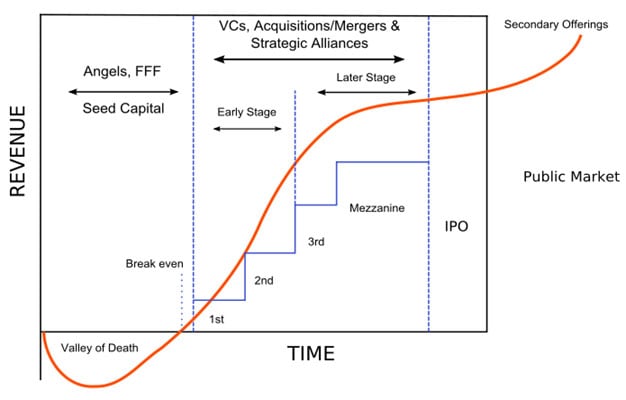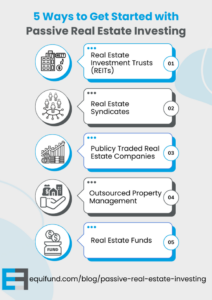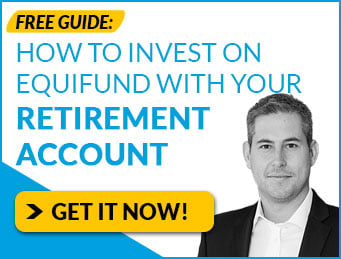One of the “Big Hairy Audacious Goals” (or BHAG) we have here at Equifund is to build a community of educated investors so large…
We can take a company from startup to IPO from our membership base!
And more importantly, to do so in a way that minimizes dilution for early shareholders and maximizes potential gains.
That’s why today, we’re going to talk about something we like to call…
The Capital Markets Slingshot
Yesterday, we discussed two of the most important concepts in investing…
The Cap Table and Capital Stack (go here to read it if you haven’t).
If you don’t have time to read it, here are the main takeaways:
- Companies raising money (aka “Issuers”) go to the Capital Markets to buy money. They do this by “issuing” Investment Products and selling them to Investors.
- While Valuation and Deal Terms are important factors to consider, the Cap Table determines what order you get paid in the event of a liquidation.
- In order to maximize potential returns for early shareholders, a proper Capital Markets Strategy is key.
However, we didn’t go into much detail on exactly how that multi-year fundraising strategy is put together in the first place.
For some context, the Equifund team has more than three decades of experience helping take small-cap companies public.
And we’ve seen first hand the problems that can happen when a company goes public too soon…
Problems that – thanks to the JOBS Act – can be avoided with proper planning.
We call our strategy the Capital Markets Slingshot.
The goal of this strategy is simple:
Get the Issuer properly set up to take in investor capital…
Take them public within the next 12 – 36 months of being listed on the Equifund Crowdfunding Portal…
And prevent them from making stupid financing mistakes along the way that destroy early shareholder value.
Here’s how it works…
If we look at the typical startup funding lifecycle, it looks something like this…
In the beginning, startups raise “Seed Capital” in order to turn their idea into a product. To raise capital, they will either need to self-fund the company, or sell Equity to “Friends, Family, and Fools” (yes, that’s a real term).
Then, once they’ve developed the MVP and enter the “Early Stage”, to raise capital, they will likely need to sell Equity to institutional investors (like venture capitalists).
As they get traction and enter the “Later Stage,” they can now start to raise both capital with Equity and Debt financing options from both institutional investors and lenders (like private equity and commercial banks)…
And once they go public, an entire universe of financing options become available to them.
However, if the Issuer goes the traditional fundraising path and raises capital from VCs and PE firms…
Unless they’re a hot startup with leverage to negotiate the best deals…
It often means the founders have to give up more equity – and more control – than they’d like.
And if they wind up bringing in the wrong investors who are not aligned with the mission and values of the business, it can create some problems for early shareholders.
Here’s what I mean: The very best companies are obsessively customer focused. However, most institutional investors are not!
Instead, they have mandates to return capital for their fund… which in many cases means they might pressure companies to do things that are not in the long-term best interest of the business (like sell it too early or go public before they’re ready).
But what if the founders could turn their customers into their investors?
What if they could turn their vendors and suppliers into investors?
Chances are, it would create far better alignment when it comes to creating both Customer Value and Shareholder Value…
We call this concept the Customer/Shareholder Flywheel (which we’ll cover in more detail another time)…
And this idea is why companies want to partner with Equifund to grow their business.
Not only are they getting access to a friendlier source of capital by going the Crowdfunding route…
They get access to a community of people who can help the company grow in ways most institutional investors simply can’t.
We call this dynamic…
The Equifund Community Flywheel
In full transparency, the Equifund Crowdfunding Portal is a Marketplace.
Our Marketplace is a Capital Market, meaning it’s a place where people come to buy and sell Capital.
And like any Marketplace, in order to grow, it’s a bit of a “chicken or the egg problem.”
- The “Buy Side” (Investors) want Access to Opportunities that help them reach their financial goals…
- The “Sell Side” (Issuers) want Access to Capital to help them build their company.
- The “Intermediary” (Equifund Crowdfunding Portal) provides Access to Resources to help facilitate the transaction.
But in order to have a functioning marketplace…
We need enough Buy Side Demand in order to have enough Capital to attract the right Sell Side…
And we need enough Sell Side Inventory in order to have the types of Opportunities required to attract the right Buy Side.
As we mentioned earlier, the best companies are relentlessly customer focused… and in our Marketplace, that means understanding how to deliver Value to all parties.
Generally speaking, this takes the form of a question which, in turn, describes the problem that needs to be solved to achieve the desired result.
However, most people don’t really understand their problem and as a result, ask the wrong questions.
The most common questions Sell Side asks are “how much can you raise for us?” and “how fast can you raise it?”…
The most common questions Buy Side asks are “how much can I make?” and “how fast can I make it?”
On the surface, these seem like legitimate questions – and maybe ones you have right now.
However, we don’t want to fix the symptoms of the problem…
Instead, we must focus on the Desired Outcome each party wants and the Core Problems preventing them from achieving it.
In pursuit of this goal, it means we have to change the conversation and help both the Buy Side and Sell Side ask different questions to reach a higher form of Value…
We think the better question for Issuers should be:
- “How do we develop the right shareholder base so we can build a business that lasts long term and help us achieve our purpose in life?”
As we’ve said already, they can always pursue the “quick cash” route and raise from institutional investors.
But this short term thinking often comes with tradeoffs that the founders might regret later on.
Which, in turn, could wind up robbing the founders of the opportunity to build a company that can create great jobs for their employees…
Deliver meaningful value to their customers…
And create long term wealth building opportunities for their shareholders by going public instead of selling early!
That’s why it’s so important to develop relationships with investors who believe in the company and are aligned with it’s values.
Which means, on the flip side, we think for Investors, the better question is…
- “How do I find investment opportunities that help me meet my long term financial goals, so I can live the lifestyle I want to live, and do so in a way that aligns with my personal values?”
Whenever I talk to retail investors, generally speaking, their Desired Outcome is some version of “freedom.”
And ironically, the Core Problem preventing them from having real freedom is the pursuit of “Get Rich Quick.”
Obviously, as investors, we want our investments to generate positive returns for us…
But a pathological need to seek lottery ticket style gains and short term profits (i.e. gambling) is the exact opposite of how real investors build sustainable wealth.
For example, we hear frequently that people want “Pre-IPO investment opportunities that will go public in the next 12 months”…
Now, there’s a lot to like about having a clear path to an exit…
But if you’re planning on dumping the shares at the IPO for a short term gain… you give up the opportunity for the long-term potential growth.
Amazon, Apple, Microsoft, or Netflix… none of those companies shot for astronomical “10,000x+ gains” at IPO, quite the opposite.
It took years (even decades) of being a public company before their real value was unlocked.
And when it finally happened, those long-term investors reaped the rewards.
This is why we invest a lot of effort into our investor education!
Because you – a member of our growing Equifund Community – are the reason companies want to list on the Equifund Crowdfunding Portal.
And we want you to have proper expectations – along with the right tools and trainings – when it comes to investing in private market opportunities.
- The more educated you are, the more confident you’ll feel when investing…
- The more confident you feel, the more likely it is you’ll invest more – and more often – in the opportunities listed on the Portal…
- The more our community invests, the more likely it is Issuers will have success on the Portal…
- The more success Issuers have, the more likely it is that more – and higher quality – Issuers will come to the Portal…
- The higher quality the Issuer, the more likely it is they will deliver returns for the investor…
- The more returns our Issuers deliver to Investors, the easier it is to grow our community…
Until one day, we – the Equifund community – become #1 option for companies who want to build great companies that are built to last.
Sincerely,
Jake Hoffberg – Publisher
Equifund


